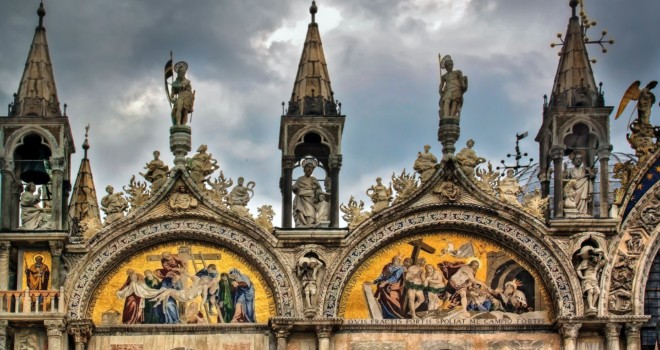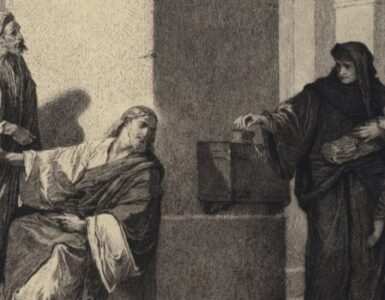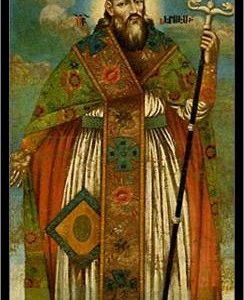It is unfortunately common to hear Catholics criticizing the Catholic Church while realizing what the Church really is. The Church is not an institution like a nonprofit organization. The Church is the Mystical Body of Christ. This teaching on the Church was first revealed to St. Paul at the time of his conversion when Jesus asked St. Paul (then called Saul) why he was persecuting Him. At that time, St. Paul had been persecuting the Church. His encounter with Jesus led him to understand that the Church is Jesus’ Mystical Body.
I first learned that the Church is the Mystical Body of Christ by reading The Divine Romance by Archbishop Fulton J. Sheen. In a chapter called “The Divine Equation,” he wrote, “The Church, then, in the language of Sacred Scripture is the body of Christ, not the physical one like to the one that was born in Bethlehem and was crucified in Jerusalem, but rather a mystical one in which He continues to live and to act and to think (though in another sense than he did in Judea and Galilee)… As His incarnation was made up of a visible and an invisible element, a human and a divine: so, too, His continued Incarnation in His Church is made up of two elements, one human and the other divine. The human element in it is poor, weak humanity, and the divine element is the life of God. …He is doing with this new body three things, as He did three things with his physical body: with it He Teaches, He Governs, and He sanctifies.” Archbishop Sheen later wrote an entire book on this subject, which I recommend, called The Mystical Body of Christ.
In the encyclical On the Mystical Body of Christ (Mystici Corporis Christi), Pope Pius XII explained why the term “mystical” is used: “There are several reasons why it should be used; for by it we may distinguish the Body of the Church, which is a Society whose Head and Ruler is Christ, from His physical Body, which, born of the Virgin Mother of God, now sits at the right hand of the Father and is hidden under the Eucharistic veils; and, that which is of greater importance in the view of modern errors, this name enables us to distinguish it from any other body, whether in the physical or in the moral order.” (60)
The Second Vatican Council expanded on the teaching of the Church as the Mystical Body of Christ in the Dogmatic Constitution on the Church, Lumen Gentium. (7) “By communicating His Spirit, Christ made His brothers, called together from all nations, mystically the components of His own Body. In that Body the life of Christ is poured into the believers who, through the sacraments, are united in a hidden and real way to Christ who suffered and was glorified.”
The Catechism of the Catholic Church also emphasizes that the Church is the Mystical Body of Christ. “The Church is the Body of Christ. Through the Spirit and his actions in the sacraments, above all the Eucharist, Christ, who once was dead and is now risen, establishes the community of believers as his own Body.” (805)
The Church teaches that receiving the Eucharist unites us to Jesus and to one another. The Mystical Body includes all the members on earth in every country and of every vocation; all the members in Heaven; and all the souls in purgatory. We are all part of the Church and united to one another. “Giving the body unity through Himself and through His power and inner joining of the members, this same Spirit produces and urges love among the believers. From all this it follows that if one member endures anything, all the members co-endure it, and if one member is honored, all the members together rejoice.” Lumen Gentium (7). This is why we must pray for and assist the members of the Church who are persecuted, who are sick, who are poor, who don’t understand the Church’s teachings, and any members who are in any need. This is also why we feel such joy when other members experience something good, such as being made a canonized saint, giving birth to a new baby, joining a religious order, or founding an apostolate.
There can be a misunderstanding among some Catholics, when they think that the only important roles in the Church are limited to those of bishops, priests, and deacons, ignoring the unique gifts they have been given as laity. St. Paul addressed this in discussing the different roles in the Church. In his Letter to the Romans, St. Paul wrote: “For as in one body we have many parts, and all the parts do not have the same function, so we, though many, are one body in Christ and individually parts of one another. Since we have gifts that differ according to the grace given to us, let us exercise them: if prophecy, in proportion to the faith; if ministry, in ministering; if one is a teacher, in teaching; if one exhorts, in exhortation; if one contributes, in generosity; if one is over others, with diligence; if one does acts of mercy, with cheerfulness.” (Romans 12:4 – 8). The lives of the saints show the great variety of ways in which Catholics have exercised the gifts that God gave them. Think of St. Gianna Molla, a wife, mother, and doctor; St. Louis and St. Zelie Martin, a married couple with children (including St. Therese of Lisieux) and business owners; and Blessed Pier Giorgio Frassati, a single university student who helped the poor and the sick and worked to oppose fascism. Each of the saints is different. They came from different countries, they had different vocations, they were given different gifts from God, and they served God and the Church in different ways. What they had in common is that they all lived lives of love: love of God and love of neighbor. They remained faithful Catholics in the Mystical Body of Christ and persevered in the Faith until they died. Reading about the saints, blesseds and other faithful Catholic witnesses can inspire us to use the gifts and talents God gave us to serve Him.
Pope Pius XII addressed the scandal caused by unfaithful and immoral Catholics. “For…Christ did not wish to exclude sinners from His Church; hence if some of her members are suffering from spiritual maladies, that is no reason why we should lessen our love for the Church, but rather a reason why we should increase our devotion to her members.” (66). Yes, through the centuries, there have been Catholics who committed terrible sins or who have taught things contrary to the doctrines of the Church. But the actions of these people are their own actions; their sins are harmful to the Church, but they do not truly represent the Church. We need to stay focused on Jesus. He will never abandon His Church. He is constantly with her and guiding her. We need to pray for the repentance and conversion of the people within the Church who have committed terrible sins because God created them and wants everyone to be saved. We need to examine our own conscience as well, and repent of our sins, and continually strive to be holy so that we may be worthy members of Jesus’ Church. We need to also continually engage in evangelization of the people outside the Church, so they may become part of the Mystical Body of Christ.
Pope Pius XII wrote about Jesus’ guidance and protection of His Church. “By this interior guidance He, the ‘Shepherd and Bishop of our souls,’ not only watches over individuals but exercises His providence over the universal Church…” (39). Pope Pius XII explained that when the Church is in danger, Jesus will save her Himself or through the intercession of the angels, the Blessed Mother, or the saints. Therefore, there is no need for Catholics to be afraid of what will happen to the Church. Jesus is always with the Church and her members. Jesus is acting in His Church today and guiding her.
In his encyclical, Pope Pius XII exhorted Catholics to love the Church. He wrote, “In order that such a solid and undivided love may abide and increase in our souls day by day, we must accustom ourselves to see Christ Himself in the Church.” (93) Knowing what it means to be part of the Church can make us very grateful to God for the gift of faith and membership in the Mystical Body, and for helping us to remain in the Church. It is through the Church that we develop a closer relationship with Jesus.
✠
Photo by sterlinglanier Lanier on Unsplash












